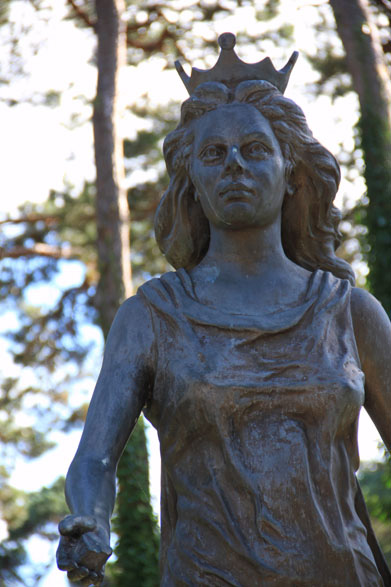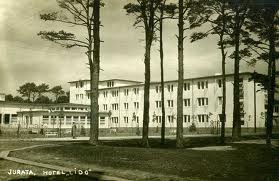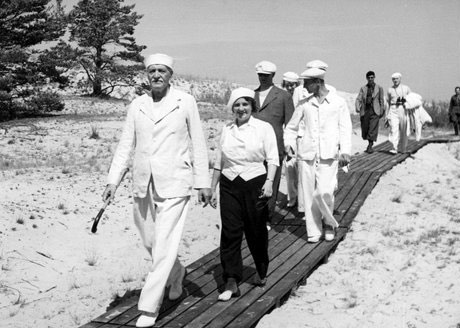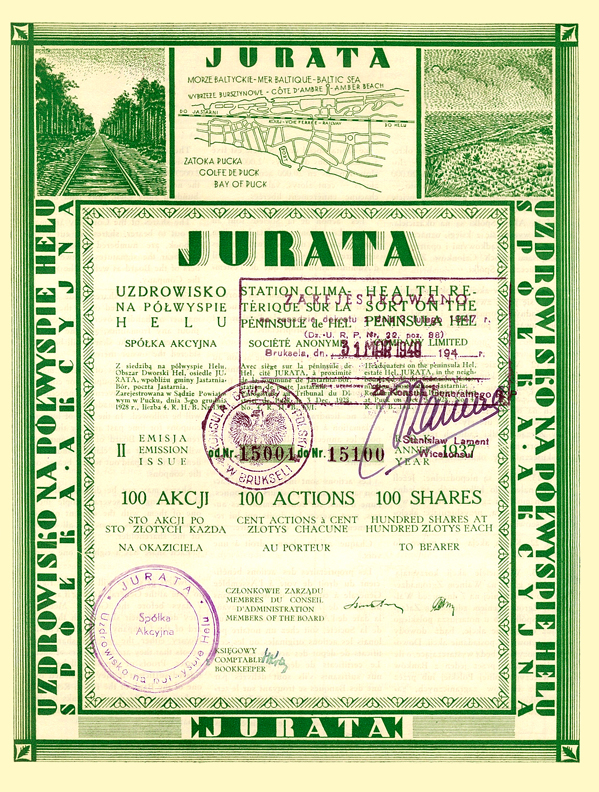
"Jurata has begun from love ..."
Legends say that the goddess Jurata lived in an amber palace at the bottom of the Baltic Sea ...
One day she heard that the fisherman Kastytis was catching too many fish from the sea, so she swam to his boat to punish him, but when she saw the fisherman she fell in love with him without memory. When the god Perkun found out about the relationship between Jurata and mortal, he destroyed the amber palace with lightning, and chained Jurata herself with chains to a rock at the bottom of the sea.
According to another application, it is Gork - the father of the beautiful goddess Jurata, upon learning of the feeling that connected his daughter with a modest fisherman, destroyed the palace at the bottom of the sea causing an unbridled storm ...
... after all, it is certain that the amber palace was shattered into thousands of drone pieces that can be found on Jurassic beaches to this day.
A modern resort of pre-war Poland
According to the intention of the builders - founders, Jurata from its beginnings to this day is a unique, most charming and the most elite place on the Polish Baltic. It was designed in accordance with the latest concepts and trends prevailing in Europe at the time, making the undeveloped place on the Baltic Sea the most modern resort in pre-war Poland, which by its standard, also today, does not diverge from world standards.
In 1932/33, an exclusive "Lido" hotel was built in Jurata, which had a direct telephone connection with Paris in the null years. Regular guests of the hotel were, among others Gen. Władysław Sikorski, Jan Kiepura, Eugeniusz Bodo, Tola Mankiewiczówna, as well as Wojciech Kossak with daughters - Magdalena Samozwaniec and Maria Jasnorzewska-Pawlikowska.
Magdalena Samozwaniec in her book Maria and Magdalena wrote that Jurata had become: "the most elegant and snobbish place on the Coast."
In 1935, the famous Cafe-Cassino located on the dunes, right by the sea, in the place of today's Hotel Bryza began its operation.


"resort from nothing"
Still at the beginning of the XX. the century was not on the map of Jurata, and the entire Hel Spit from the partition in 1772 remained under Prussia until 1920.
In the years 1922/23 a railway line to Hel was built on the peninsula and since then one can speak of the development of tourism in this area.
Sama Jurata została założona dopiero w 1928 r. przez przedsiębiorców, którzy założywszy spółkę Jurata S.A. wydzierżawili od państwa 150 ha ziemi i rozpoczęli prace budowlane wznosząc pomiędzy dwiema miejscowościami rybackimi – Jastarnią i Helem – piękne wille, domy letniskowe i pensjonaty.
Until then, there were only dunes and pine forest, whipped by the coastal breeze, inhabited by wild animals and hosts of migratory birds.
The first season in Jurata began in 1931, and the information brochure published on this occasion wrote:
(...) the constant temperature in this town is much milder, due to covering the forests that protect against the wind, than it is in Gdynia and even in Warsaw, and on the entire sea coast. An even greater difference in favor of Jurata can be seen in terms of the number of sunny days with high insolation.
In 1935 an asphalt road was built on the peninsula, and from then on, summer vacationers could, apart from the railroad and the ship from Gdynia, travel - very fashionable at the time - in automobiles.

Jurata from years ago, just like now, is a place where one simply "should be".
Swoje rezydencje mieli tu niegdyś m.in. ks. Czetwertyńscy, hr. Potoccy, hr. Tyszkiewiczowie, Ignacy Mościcki czy Józef Beck. W bezpośrednim sąsiedztwie Juraty, chociaż już w obrębie Helu, letnią rezydencję posiada także Prezydent RP
It is here where representatives of culture and art regularly relax, as well as Polish stage stars and politicians. On the Jurassic pier, built in the 70s of the last century, you can meet Wojciech Mann, Krzysztof Materna, Jan Englert, Maciej Orłoś and many, many more ...
... join them!
Famous and liked on vacation in Jurata
Jurata, from the beginning of its existence, guests distinguished representatives of public life. Among vacationers, well-known and liked, who have grown up as the regulars of the resort once belonged or remain today:
– Władysław Sikorski (1881 - 1943) - weapons general of the Polish Army, commander-in-chief of the Polish Armed Forces, Prime Minister of the Polish Government-in-Exile during World War II.
– Jan Kiepura (1902 - 1966) - Polish singer (tenor) and actor, the most popular Polish singer of the interwar period.
– Eugeniusz Bodo (1899 - 1943) - Polish film, revue and theater actor, screenwriter, director, dancer, singer, film producer.
– Tola Mankiewiczówna (1900 - 1985) - Polish actress, singer, opera singer (lyrical soprano). One of the most popular artists of the interwar period.
– Wojciech Horacy Kossak h. Kos (1856 - 1942) - Polish historical and battle painter, co-author of Panorama Racławicka.
– Maria Jasnorzewska-Pawlikowska, née Kossak, pv Bzowska, p. Pawlikowska, t. Jasnorzewska (1891-1945) - Polish poet and playwright of the interwar period.
– Magdalena Samozwaniec, née Kossak, pv Starzewska, p. Niewidowska (1894 - 1972) - Polish satirical writer.
– Ignacy Mościcki (1867 - 1946) - Polish politician and chemist. The President of the Republic of Poland in 1926-1939. Scientist, inventor. In the years 1912-1922 a professor at the Lviv Polytechnic, later a rector. Author of an innovative method of obtaining nitric acid from air.
– Józef Beck (1894 - 1944) - Polish politician, diplomat, close associate and deputy prime minister in the government of Józef Piłsudski.
– Mieczysław Lurczyński (1907 - 1992) - Polish writer, poet, painter.
– Wojciech Weiss (1875 - 1950) - Polish painter, professor and rector of the Krakow Academy of Fine Arts.
– Jadwiga Smolarska (1898 - 1971) - Polish theater and film actress.
– Marta Cegielska (1887 - 1985) - dancer, creator of the dance group "Sisters Halama" with daughters: Zizi (Józefina) Halama, Ice (Leokadia) Halama, Punia (Alicja) Halama, Ena (Helena) Halama
– hr. Potocki
– hr. Tyszkiewicz
– Fr.. Czetwrtyńscy
– Grzegorz Halama
– Maciej Orłoś
– Jan Englert
– Jerzy Iwaszkiewicz
During EURO 2012, Jurata was also visited by members of international football teams with their families, among them Shakira.



